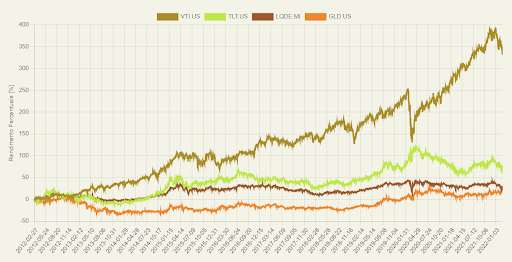What is expected return and how to use it
A practical guide to understand expected return, read it inside Wallible reports, and compare it with other performance metrics.
Sunday, 5 October 2025

Why we talk about expected return
When we review a portfolio, the first number that usually grabs the spotlight is the cumulative gain. Expected return gives us a quick snapshot of how much the portfolio, or a single instrument, earned on average in each period. It is an immediate metric that Wallible highlights next to richer indicators such as CAGR, Sharpe ratio, or annualised return.
Definition in plain words
Expected return is the arithmetic mean of the periodic returns. If we measure the monthly returns of an ETF over one year, the expected return tells us how much the ETF gained (or lost) on average every month in that stretch.
The formula
If we label the percentage returns of each period as $R_1, R_2, \ldots, R_n$, then:
$R_{expected} = \frac{1}{n} \sum_{i=1}^{n} R_i$
The outcome shares the same scale as the input returns. Work with monthly returns and you will get a monthly expected return; feed annual figures and you will read an annual expected return.
A concrete example
Consider a portfolio with the following quarterly performance:
| Quarter | Return |
|---|---|
| Q1 | +4.0% |
| Q2 | -1.5% |
| Q3 | +2.2% |
| Q4 | +3.3% |
The quarterly expected return is:
$R_{expected} = \frac{4.0 - 1.5 + 2.2 + 3.3}{4} = 2.0%$
In other words, the portfolio delivered a +2% average gain per quarter across the period.
Strengths
- Straightforward: quick to calculate and easy to interpret.
- Comparable: lets you line up different instruments or strategies over the same time window.
- Decision support: helps you judge whether a portfolio is tracking the expectations you set out.
Limitations
- Ignores compounding: unlike CAGR, it does not capture the effect of interest on interest.
- Sensitive to outliers: a single very strong (or very weak) period can move the entire average.
- Silent on volatility: two portfolios may share the same expected return but take very different risks to get there.
Reading it inside Wallible
Open the Metrics tab of your portfolio and you will spot expected return next to annualised return, CAGR, and the rest of the dashboard. A practical workflow is to:
- compare your expected return with a benchmark (for example the MSCI World) over the same horizon;
- check whether it aligns with your personal target (say the return you need to reach a financial goal);
- cross-check it with risk metrics (volatility, max drawdown) to confirm that the outcome came with acceptable risk.
Expected return vs annualised return
| Feature | Expected return | Annualised return |
|---|---|---|
| What it captures | Arithmetic average of the periodic returns | Equivalent yearly growth once compounding is taken into account |
| When to use it | For quick comparisons and homogeneous data sets | To assess long-term growth in compounded terms |
| Sensitivity to swings | High | Lower: compounding smooths the ups and downs |
In short, expected return is perfect for immediate comparisons, while annualised return explains the compounding effect over time. Using them together offers a fuller reading.
Frequently asked questions
Can expected return be negative? Yes. If the sum of the periodic returns is negative, the average follows. That signals the portfolio spent more periods in the red than in the black.
How can I improve my expected return? There is no magic recipe, yet sound diversification, cost control, and sticking to a consistent plan reduce the impact of setbacks on the average result.
How does it differ from total return? Total return shows how much capital rose (or fell) altogether during the interval. Expected return spreads that outcome over the single periods, highlighting the “average speed” at which it was achieved.
Disclaimer
This article is not financial advice but an example based on studies, research and analysis conducted by our team.
Discover how easy it is to replicate this analysis and many other investment strategies in the Wallible app. With free registration you get access to all the tools.
Sign up for free